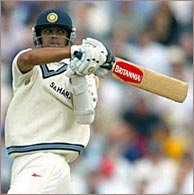December 6, 2002


|
Can India get rid of it and win a Test series abroad? A preview of the New Zealand tour.
Prem Panicker & Faisal Shariff Shortly before the team left India for the West Indies, earlier this year, John Wright called a team meeting -- and this is what he told them: Look, guys, the biggest goal for the Test team has to be winning a series abroad, and ending the 16-year losing streak. Look around you, and the three teams -- outside of Bangladesh and Zimbabwe -- that you should find easiest to beat are the West Indies, England and New Zealand. So, surprise, surprise, those are the three teams we are playing this year -- if we don't break that 16-year losing streak this year, we are in serious trouble. So hey, 2002 is into its 11th hour (or 12th month) -- so what do we have to show for it? The four-Test series against the West Indies in April-May ended 2-1 for the Windies. The consolation prize was that India won a Test in Caribbean for the first time in 26 years -- the last was in April 1976 when, powered by the bowling of the spin troika of Bedi, Chandrasekhar and Venkataraghavan and a strong second innings batting performance led by centurions Sunil Gavaskar and brother-in-law Gundappa Vishwanath, India won by six wickets (in passing, the final scoreline of that series, too, read 2-1 in favour of the hosts).
"We are winning Tests abroad now, which we haven't done in years," team vice-captain Rahul Dravid told us a while ago. "We have even gotten into positions where we could have won the series -- but then something or the other happened. The trick I guess is to keep doing this, winning Tests abroad and putting ourselves in position to take the series -- if we can keep focused on that, then sooner than later, we'll pull off the series win and get that monkey off our backs." Come December 12, the team has its latest -- some would say best -- shot at jettisoning that monkey, when it plays New Zealand in the first of two Tests. The playing XI picks itself: Virender Sehwag, Sanjay Bangar, Rahul Dravid, Sachin Tendulkar, Sourav Ganguly, VVS Laxman, Parthiv Patel, Murali Karthik, Ajit Agarkar, Harbhajan Singh and Zaheer Khan. In that line-up, the debatable inclusion could be Agarkar -- does India dare risk his prodigality when he is one of just two seamers going into an away Test, in seaming conditions? Not if you had, say, a Javagal Srinath who, though ageing, is still capable of potent first spells -- but given that the fading Karnataka veteran has been rested, Agarkar gets the spot only because the heir apparent for the position, Ashish Nehra, has been in even worse form. The latest available yardstick, keeping in mind we are talking of away tours, is England -- where Agarkar picked up 8 for 488 at average 61, to Nehra's 5 for 319 at 63.8. Not much of a choice -- but the fact is, India's seam bowling cupboard is dangerously bare and, in the circumstances, the team management will opt to go with Agarkar if only because he can, theoretically, bat higher than number 11 and doesn't have to be hidden in the field. This in turn means Bangar will end up doing a fair amount of bowling, as cover. In context of the above, if you are fresh out of nightmares, here's one to take to bed with you: what happens if Zaheer Khan breaks down? Putting aside the debate on Agarkar for the moment, the rest of the line-up picks itself -- though it is hard lines that Mohammad Kaif cannot force his way into the top six except in the event of injury (the failure of one of the batsmen is not really an opportunity, given that this is just a two-Test series, and no senior batsman averaging 45 and above is going to be dropped on the basis of one failure). What is immediately obvious is that there really is only one possible game-plan open to India: Look to bat just once, and pile up enough runs to give the bowlers plenty to work with, plus the time to do that work in. The positive bit that India will take into the opening game is this: the selfsame batting line-up, when last tested on a seaming track at Trent Bridge, made 357 and 424. This time round, with Chris Cairns out of the reckoning, they will be opposed primarily by the pace of Shane Bond, and the left arm spin of Daniel Vettori. The latter is unlikely to pose too serious a threat unless the pitch is really turning -- so if India is looking to put runs on the board, this is as good a chance as they will ever get. The danger, too, is equally obvious: India invariably starts off badly on tour (as witness, by way of latest example, the capitulation in ideal batting conditions in the first Test at Lord's). In England, an early defeat could be shrugged off given there were three Tests to follow -- on this current two-Test tour, that first chance is all you get. So it all comes down -- as Test matches invariably do -- to the bowling. Throughout the recent home series against the West Indies, much media space was taken up with laments over the missing Zaheer Khan. In one sense, that could be construed as absence making the heart go -- the last series Zaheer played in was the one against England, where his 11 wickets for 483 at 43.91 compared unfavorably with Harbhajan Singh's 12 wickets for 410 at 34.17 and the now mysteriously absent Anil Kumble's 14 wickets for 504 at 36.00.
The real key, though -- and keep in mind that the Kiwis are hardly likely to play into India's hands by providing turning tracks -- are the spin twins, Harbhajan Singh and Murali Kartik. Bajji has played just one Test in New Zealand (Kartik obviously has none to his name): his third career outing, at Basin Reserve in December 1998. In the first innings, he got 25 overs, and went nought for 61 (Kumble 4/83, Tendulkar 2/7). And in the second innings, he bowled just five overs, for 11 runs. Not the sort of precedent you want to remember -- but then again, the Bajji who went to New Zealand in 1998 was not the one who took 32 wickets against Australia two years later to spearhead contemporary India's finest win. The really interesting commodity is Kartik -- a bowler who comes into the team carrying quite a bit of baggage. His bowling skills are unquestioned -- as early as 2000, Dravid was telling us that in his book, Kartik was "the best left arm spinner in the country, bar none". The key question is his equation with skipper Ganguly -- which, till date, has been none too good. There is one good reason why the two could turn out to be best buddies on the field, this time round: Kartik is dead keen to edge out the absent Anil Kumble and cement his place in the side, and Ganguly is even keener to set the seal on his captaincy record by leading India to an away series win. Given the alternative, the two will probably want to scale new heights in synchronized swimming. For India to have a chance, its three bowlers will need to click in tandem. One extra edge this team brings, which its immediate predecessors didn't, is attitude -- thanks in part to Ganguly's willingness to go the extra mile in backing his players, and in part to the energetic and, at times, acerbic inputs of John Wright in the background, the side has gradually shed much of the inhibitions and fears it took along on foreign tours. With Adrian le Roux and Andrew Leipus combining to produce probably the fittest Indian team in the last two decades, with Ganguly aggressively fronting them and Wright bringing up the rear with a whip he is never shy to wield, the team now has more bounce per ounce than its predecessors. And more than the batting and bowling, it is perhaps this quality the team will draw on when the going gets tough.
At this point, we are not privy to what Wright said at the meeting before
the team left for New Zealand -- but it wouldn't surprise us if his words
were 'Right, boys, Windies and England, that is two strikes -- the Kiwis are
your last chance.' Because the highlight of India's 'away' program in 2004
is a possible four-Test series against Australia -- and as Wright would say,
"That is serious shit".
|
|
|
 Then came the four-Test
Then came the four-Test  Those statistics, however, disguise one crucial fact -- when things got tough
on the England tour and the captain looked around, it was invariably Zaheer
who put his hand up, and delivered. Fitness permitting, the upcoming series
should see him, now officially ensconced as the team's seam spearhead,
flower.
Those statistics, however, disguise one crucial fact -- when things got tough
on the England tour and the captain looked around, it was invariably Zaheer
who put his hand up, and delivered. Fitness permitting, the upcoming series
should see him, now officially ensconced as the team's seam spearhead,
flower.